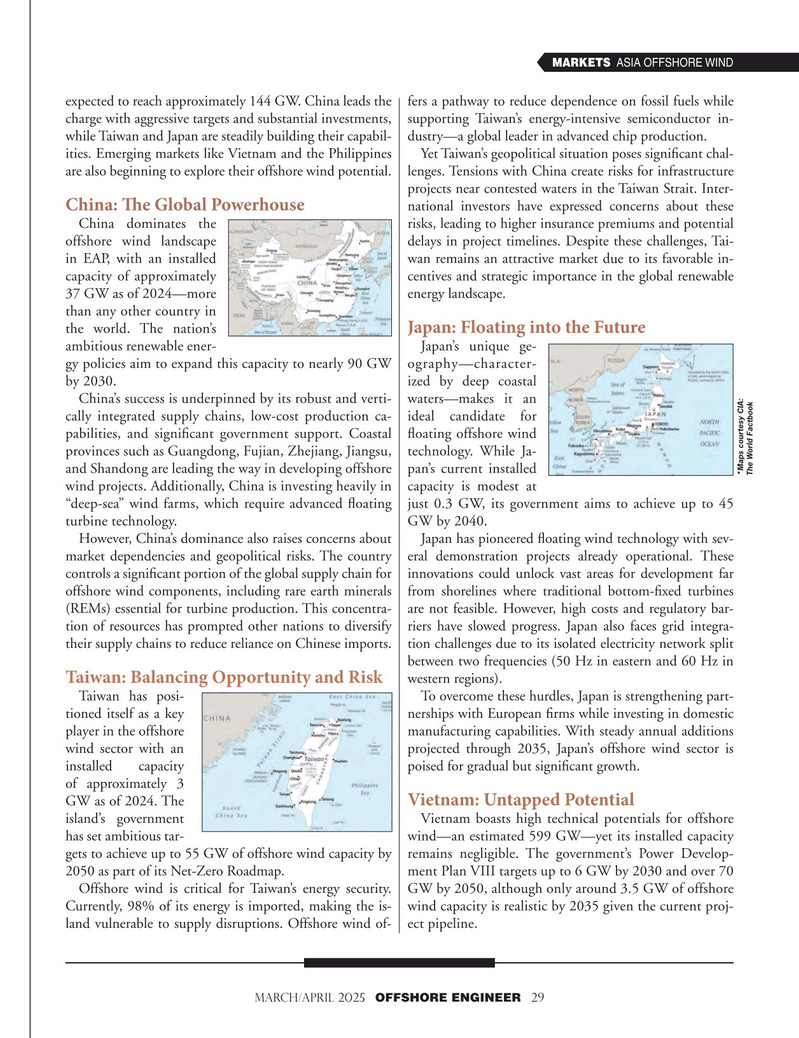
Page 29: of Offshore Engineer Magazine (Mar/Apr 2025)
Read this page in Pdf, Flash or Html5 edition of Mar/Apr 2025 Offshore Engineer Magazine
MARKETS ASIA OFFSHORE WIND expected to reach approximately 144 GW. China leads the fers a pathway to reduce dependence on fossil fuels while charge with aggressive targets and substantial investments, supporting Taiwan’s energy-intensive semiconductor in- while Taiwan and Japan are steadily building their capabil- dustry—a global leader in advanced chip production. ities. Emerging markets like Vietnam and the Philippines Yet Taiwan’s geopolitical situation poses signifcant chal- are also beginning to explore their offshore wind potential. lenges. Tensions with China create risks for infrastructure projects near contested waters in the Taiwan Strait. Inter-
China: Te Global Powerhouse national investors have expressed concerns about these
China dominates the risks, leading to higher insurance premiums and potential offshore wind landscape delays in project timelines. Despite these challenges, Tai- in EAP, with an installed wan remains an attractive market due to its favorable in- capacity of approximately centives and strategic importance in the global renewable 37 GW as of 2024—more energy landscape. than any other country in
Japan: Floating into the Future the world. The nation’s ambitious renewable ener- Japan’s unique ge- gy policies aim to expand this capacity to nearly 90 GW ography—character- by 2030. ized by deep coastal
China’s success is underpinned by its robust and verti- waters—makes it an cally integrated supply chains, low-cost production ca- ideal candidate for pabilities, and signifcant government support. Coastal foating offshore wind provinces such as Guangdong, Fujian, Zhejiang, Jiangsu, technology. While Ja- and Shandong are leading the way in developing offshore pan’s current installed *Maps courtesy CIA:
The World Factbook wind projects. Additionally, China is investing heavily in capacity is modest at “deep-sea” wind farms, which require advanced foating just 0.3 GW, its government aims to achieve up to 45 turbine technology. GW by 2040.
However, China’s dominance also raises concerns about Japan has pioneered foating wind technology with sev- market dependencies and geopolitical risks. The country eral demonstration projects already operational. These controls a signifcant portion of the global supply chain for innovations could unlock vast areas for development far offshore wind components, including rare earth minerals from shorelines where traditional bottom-fxed turbines (REMs) essential for turbine production. This concentra- are not feasible. However, high costs and regulatory bar- tion of resources has prompted other nations to diversify riers have slowed progress. Japan also faces grid integra- their supply chains to reduce reliance on Chinese imports. tion challenges due to its isolated electricity network split between two frequencies (50 Hz in eastern and 60 Hz in
Taiwan: Balancing Opportunity and Risk western regions).
Taiwan has posi- To overcome these hurdles, Japan is strengthening part- tioned itself as a key nerships with European frms while investing in domestic player in the offshore manufacturing capabilities. With steady annual additions wind sector with an projected through 2035, Japan’s offshore wind sector is installed capacity poised for gradual but signifcant growth.
of approximately 3
Vietnam: Untapped Potential
GW as of 2024. The island’s government Vietnam boasts high technical potentials for offshore has set ambitious tar- wind—an estimated 599 GW—yet its installed capacity gets to achieve up to 55 GW of offshore wind capacity by remains negligible. The government’s Power Develop- 2050 as part of its Net-Zero Roadmap. ment Plan VIII targets up to 6 GW by 2030 and over 70
Offshore wind is critical for Taiwan’s energy security. GW by 2050, although only around 3.5 GW of offshore
Currently, 98% of its energy is imported, making the is- wind capacity is realistic by 2035 given the current proj- land vulnerable to supply disruptions. Offshore wind of- ect pipeline.
march/april 2025 OFFSHORE ENGINEER 29

 28
28

 30
30